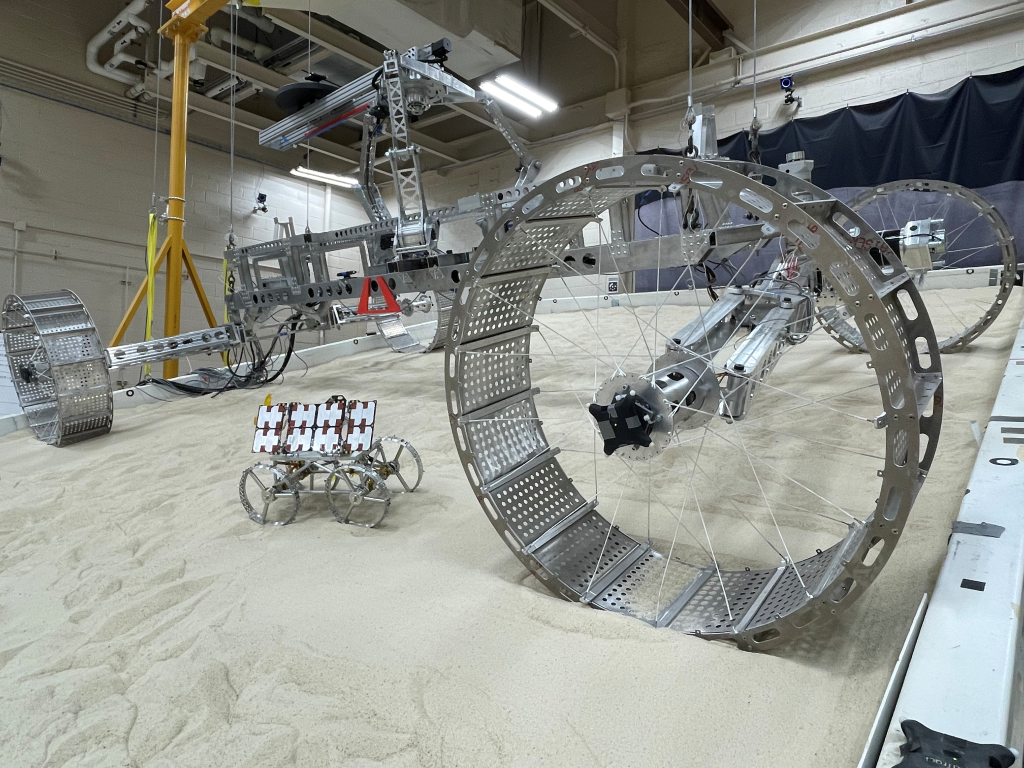Press Releases
Astrobotic’s Mobile Lunar Power Asset Completes Surface Stability Testing

| Astrobotic is one step closer to establishing a lunar power grid with the initiation of a summer-long test campaign for its VSAT Optimized for Lunar Traverse (VOLT). VOLT is a specialized lunar rover equipped with a vertical solar array designed to drive across the Moon, and harness solar energy to charge a variety of lunar surface assets like habitats, rovers, and science instruments at lunar south pole. An engineering model of VOLT’s mobile rover base underwent testing in the Simulated Lunar Operations Laboratory (SLOPE) at NASA’s Glenn Research Center in Cleveland. The tests demonstrated the vehicle’s stability, gimbal functionality, and sun tracking capabilities on an inclined bed of lunar regolith simulant. Although VOLT was designed to operate on a 15-degree incline, it surpassed expectations by remaining completely stable on a 20-degree slope with no slippage. Furthermore, VOLT’s gimbal maintained a level position within a 3-degree tolerance, confirming its capability to support the 60-foot vertical solar array that will be integrated later this year. NASA Glenn’s motion capture cameras validated the stability of the lunar rover while resting on a regolith surface, ensuring the vehicle’s stability on inclined terrain, analogous to what is expected to be found at the lunar south pole. “To supply continuous power at the poles of the Moon, we need to take advantage of existing peaks of persistent light: locations with near constant sunlight throughout the year. Since most of these locations are at crater rims with high slope angles, we designed VOLT to deploy on extreme slopes. These tests proved that our system can operate successfully, with plenty of margin for more extreme locations,” says Robert Rolley, Astrobotic’s Principal Investigator for VOLT. |
 |
| Image: Astrobotic’s VOLT in testing at NASA Glenn Research Center’s SLOPE Lab. Pictured with CubeRover for scale. |
| Prior to the test campaign, Astrobotic’s team engineered, prototyped, and assembled the VOLT’s mobile base, a lunar rover with a chassis the size of a minivan. The entire structure – including the electronics and gimbal – were all assembled within 12 weeks. The gimbal system is key to optimally orienting a solar array on the Moon to capture solar energy, level the array on uneven terrain, and maintain stability while the array tracks the Sun autonomously in 360 degrees. VOLT can be delivered to the Moon aboard Astrobotic’s Griffin lunar lander and egress onto the surface to operate independently without a tow from another vehicle. VOLT is a key part of Astrobotic’s LunaGrid system to deliver power on the Moon. LunaGrid is a network of tethered VOLTs that generate power. Power is distributed from VOLTs both via wired connections and wireless chargers onboard tethered CubeRovers, which act as mobile power plugs. LunaGrid will supply power to enable systems to operate during the lunar day and then survive the lunar night for months at a time. “It’s imperative that we solve the power-generation challenge on the Moon for sustainable long-term operations,” said John Landreneau, Senior Project Manager at Astrobotic. “VOLT’s ability to precisely drive and operate in the most desirable areas for solar capture and distribution sets this technology apart. With strategic partnerships and novel tech developed in-house by our team, VOLT and the LunaGrid system are making great progress to bring reliable power to lunar surface systems like landers, rovers, habitats, and science suites.” The first unveiling of the entire VOLT engineering model is planned for late October during the annual Keystone Space Conference held in Pittsburgh, PA. Astrobotic plans to deploy and demonstrate LunaGrid elements on the lunar surface no earlier than mid-2026 with the goal of the first operational LunaGrid by 2028 at the Moon’s south pole. |
| About Astrobotic Astrobotic is at the forefront of advancing space exploration and technology development. Our expertise spans from lunar rovers, landers, navigation, machine vision, and infrastructure to terrestrial rockets and mesh GPS systems for austere environments. To date, the company has been contracted for two lunar missions, and has won more than 60 NASA, DoD, and commercial technology contracts worth more than $600 million. We recently launched and operated the first American lunar lander mission since the Apollo Program. Beyond helping lead America back to the Moon, Astrobotic develops and operates reusable vertical takeoff, vertical landing (VTVL) rockets and advanced rocket engines. Established in 2007, Astrobotic is headquartered in Pittsburgh, PA, with a propulsion and test campus in Mojave, CA.www.astrobotic.com |





